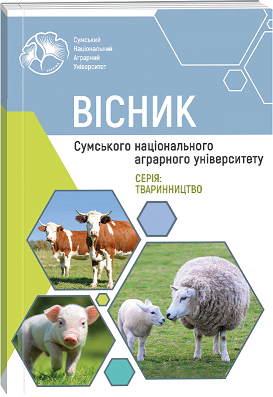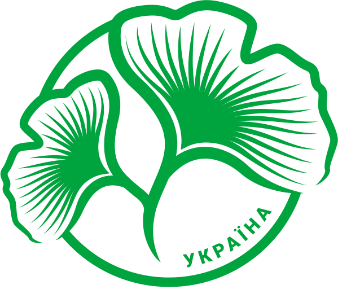GROWTH INTENSITY OF PIGS ON FATTENING WITH THE USE OF AMINO ACID ADDITIVES IN AN INDUSTRIAL PIG COMPLEX
Abstract
To study the impact of different levels and degrees of protein digestibility in the diet supplemented with amino acid additives on the fattening qualities of hybrid pigs, an experiment was conducted to investigate the fattening qualities of F1 hybrid pigs obtained by crossing two-breed sows (LWxL) with terminal boars PIC-337. The experiment was carried out in the conditions of the "Ryabushkivsky Bacon" pig complex in the Sumy region. Various levels and degrees of protein digestibility were used in the pigs' diet. The study included 6 groups of 20 heads, divided by live weight and sex. During the leveling period, which lasted 30 days, all pigs received the same diet. After this period, 5 animals from each group with excessive or insufficient weight gain were removed. Then, for 16 days, the animals continued to consume the same feed with the goal of reaching a weight of 110 kg. On the 47th day of fattening, the pigs were divided into three groups by weight (58 kg, 66 kg, and 77 kg) and kept in pens with slatted floors, with 15 heads in each pen. The first half of the pigs received feed with easily digestible protein, while the second half received feed with hard-to-digest protein and the feed additive AminoPro. Throughout the entire experiment, all groups were provided with a dry compound feed of their own production, made from high-protein feed materials with the addition of crushed ingredients. The compound feed was distributed manually twice a day in feeders with partitions that allowed 15 animals to consume the feed simultaneously. The results of the study showed that lightweight piglets consuming a standard diet with easily digestible protein had a final weight that was 2.10 kg or 1.56% higher compared to those receiving a diet with hard-to-digest protein and the AminoPro additive. Pigs with an average initial weight that consumed the standard feed showed a higher weight by 2.60 kg or 1.84% compared to the control group. No differences were found in the pre-slaughter weight of pigs with the highest initial weight across different diets. The absolute gain in pigs consuming feed with AminoPro was 4.60 kg or 6.03% higher compared to those receiving standard feed. Daily gains were also higher in the average weight pigs that consumed the feed with AminoPro, by 53 g or 6.04%. No significant difference was found in the age at which animals reached a weight of 100 kg between those consuming standard and experimental feed. Pigs with a low initial weight that consumed standard feed had a better feed conversion of 0.07 kg per 1 kg of gain compared to those on the experimental diet. Average-weight pigs consuming experimental feed with hard-todigest protein had lower feed costs of 0.27 kg per 1 kg of gain compared to animals on the standard diet. A higher fattening quality index was established in all groups of pigs consuming the experimental feed, regardless of their initial weight. Additionally, a high correlation was observed between the initial and final fattening weights and other growth indicators. The study revealed a strong direct relationship between daily and absolute gains, as well as a moderate direct relationship between absolute and relative gains. Relative gain showed a weak but significant direct relationship with the age at which a live weight of 100 kg was reached, while absolute gain had a moderate inverse relationship with this indicator. The results of this study will be useful for pig complexes aiming to optimize feeding rations, improve daily gains, and reduce feed costs, which is essential for increasing production profitability.
References
2. Cappelaere, L., Le Cour Grandmaison, J., Martin, N., Lambert, W. (2021). Amino Acid Supplementation to Reduce Environmental Impacts of Broiler and Pig Production: A Review. Frontiers in veterinary science, 8, 689259. https://doi.org/10.3389/fvets.2021.689259
3. Cônsolo, N. R. B., Silva, J. D., Buarque, V. L. M., Higuera-Padilla, A., Barbosa, L. C. G. S., Zawadzki, A., Colnago, L. A., Netto, A. S., Gerrard, D. E., Silva, S. L. (2020). Selection for Growth and Precocity Alters Muscle Metabolism in Nellore Cattle. Metabolites, 10(2), 58. https://doi.org/10.3390/metabo10020058
4. Council Directive, (2010). 86/609/EEC of 24 November 1986 on the approximation of laws, regulations and administrative provisions of the Member States regarding the protection of animals used for experimental and other scientific purposes. [Elektronnyi resurs]. – Rezhym dostupu: https://www.animallaw.info/statute/eu-research-council-directive-86609eec-regarding-protection-animals-used-experimental-and (data zvernennia 20.10.2024)
5. Dilger, A.C., Chen, X., Honegger, L.T. et al. The potential for gene-editing to increase muscle growth in pigs: experiences with editing myostatin. CABI Agric Biosci 3, 36 (2022). https://doi.org/10.1186/s43170-022-00106-6
6. Duarte, M.E., Parnsen, W., Zhang, S. (2024). Low crude protein formulation with supplemental amino acids for its impacts on intestinal health and growth performance of growing-finishing pigs. J Animal Sci Biotechnol 15, 55. https://doi.org/10.1186/s40104-024-01015-6
7. Durkin, I., Dadic, M., Brkic, D., Lukic, B., Kusec, G., Mikolin, M. (2012). influence of gender and slaughter weight on meat quality traits of heavy pigs. Acta Agric Slov., 3, 211–4. https://doi.org/10.1139/ cjas-2017-0032
8. Ellis, M., Avery, P. J. (1994). The influence of heavy slaughter weights on growth and carcass characteristics of pigs. British Society of Animal Production, 5, 569. https://doi.org/10.1017/S030822960001864X
9. Esteves, L. A. C., Monteiro, A. N. T. R., Sitanaka, N. Y., Oliveira, P. C., Castilha, L. D., Paula, V. R. C., Pozza, P. C. (2021). The Reduction of Crude Protein with the Supplementation of Amino Acids in the Diet Reduces the Environmental Impact of Growing Pigs Production Evaluated through Life Cycle Assessment. Sustainability, 13, 4815. https://doi.org/10.3390/su13094815
10. Hu, N., Shen, Z., Pan, L., Qin, G., Zhao, Y., Bao, N. (2022). Effects of protein content and the inclusion of protein sources with different amino acid release dynamics on the nitrogen utilization of weaned piglets. Animal bioscience, 35(2), 260–271. https://doi.org/10.5713/ab.21.0142
11. Huting, A. M. S., Sakkas, P., Wellock, I. (2018). Once small always small? To what extent morphometric characteristics and post-weaning starter regime affect pig lifetime growth performance. Porc Health Manag., 4, 21. https://doi.org/10.1186/s40813-018-0098-1
12. Khmelnychyi, L. M., Vecherka, V. V., Shpetnyi, M. B., Bordunova, O. H., Pavlenko, Yu. M., Opara, V. O. (2020). Vidhodivelni ta zabiini yakosti svynei riznykh vahovykh katehorii doroshchenykh u stankakh na polimernii ta betonnii pidlozi [Fattening and slaughter qualities of pigs of different weight categories reared in machines on polymer and concrete floors]. Bulletin of the Sumy National Agrarian University. "Livestock" series, 1 (40), 1–9. https://doi.org/10.32845/bsnau.lvst.2020.1.1 [in Ukrainian]
13. Kramarenko, S. S., Lugovou, S. I., Lykhach, A. V., Kramarenko O. S. (2019). Analiz biometrychnykh danykh u rozvedenni ta selektsii tvaryn [Analysis of biometric data in animal breeding and selection]. Mykolauiv: MNAU, 211. [in Ukrainian]
14. Langyan, S., Yadava, P., Khan, F. N., Dar, Z. A., Singh, R., Kumar, A. (2022). Sustaining Protein Nutrition Through Plant-Based Foods. Frontiers in nutrition, 8, 772573. https://doi.org/10.3389/fnut.2021.772573
15. Ladyka, V. I., Khmelnychiy, L. M. & Povod, M. G. (2023). Tekhnolohiia vyrobnytstva ta pererobky produktsii tvarynnytstva: pidruchnyk dlia aspirantiv [Technology of production and processing of livestock products: a textbook for graduate students]. Odesa: Oldi+, 244. (іn Ukrainian)
16. Latorre, M. A., Lázaro, R., Valencia, D. G., Medel, P., Mateos, G. G. (2004). The effects of gender and slaughter weight on the growth performance, carcass traits, and meat quality characteristics of heavy pigs. J Anim Sci., 82, 526–33. https://doi.org/10.2527/2004.822526x
17. López-Vergé, S., Gasa, J., Temple, D. (2018). Strategies to improve the growth and homogeneity of growing-finishing pigs: feeder space and feeding management. Porc Health Manag., 4, 14. https://doi.org/10.1186/s40813-018-0090-9
18. Lykhach, V. Ya., Lykhach, A. V., Faustov, R. V., Kucher, O. O. (2021). Suchasnyi stan ta tendentsii rozvytku vitchyznianoho svynarstva [Current state and trends in the development of domestic pig farming]. Bulletin of the Sumy National Agrarian University. "Livestock" series, 1(44), 69–71. https://doi.org/10.32845/bsnau.lvst.2021.1.10 (іn Ukrainian)
19. Lykhach, V. Ya., Povod, M. G., Shpetny, M. B., Nechmilov, V. M., Lykhach, A. V., Mykhalko, O. G., Barkar, E. V., Lenkov, L. G., Kucher, O. O. (2023). Optymizatsiia tekhnolohichnykh rishen utrymannia ta hodivli svynei v umovakh promyslovoi tekhnolohii [Optimization of technological solutions for keeping and feeding pigs in conditions of industrial technology]: monograph. Mykolayiv: Ilion, 518. (іn Ukrainian)
20. Ma, X., Yu, M., Liu, Z., Deng, D., Cui, Y., Tian, Z., & Wang, G. (2020). Effect of amino acids and their derivatives on meat quality of finishing pigs. Journal of food science and technology, 57(2), 404–412. https://doi.org/10.1007/s13197-019-04077-x
21. Mykhalko, O. G. (2021a). Suchasnyi stan ta shliakhy rozvytku svynarstva v sviti ta Ukraini [The current state and ways of development of pig farming in the world and in Ukraine]. Bulletin of the Sumy National Agrarian University. Series «Livestock», 3, 60–77. https://doi.org/10.32845/bsnau.lvst.2021.3.9 [in Ukrainian]
22. Mykhalko, O. G. (2021b). Vidhodivelni yakosti svynei irlandskoho pokhodzhennia za riznoho typu hodivli [Feeding qualities of pigs of Irish origin under different types of feeding]. Bulletin of the Sumy National Agrarian University. "Livestock" series, 3, 51–56. https://doi.org/10.32845/bsnau.lvst.2020.3.9 [in Ukrainian]
23. Mykhalko, O. G. (2021c). Zalezhnist vid hodivelnykh yakostei svynei danskoho pokhodzhennia vid typu hodivli [Dependence of the feeding qualities of pigs of Danish origin on the type of feeding]. Bulletin of the Sumy National Agrarian University. "Livestock" series, 4(47), 99–108. https://doi.org/10.32845/bsnau.lvst.2021.4.17 [in Ukrainian]
24. Mykhalko, O. G., Levchenko, I. V. (2022). Stan svynarskoi haluzi Sumskoi oblasti [Stage of pig breeding at Sumy region]. Bulletin of the Sumy National Agrarian University. Series «Livestock», 3(50), 18–30. https://doi.org/10.32845/bsnau.lvst.2022.3.3 (іn Ukrainian)
25. Peinado, J., Serrano, M. P., Nieto, M., Medel, P, Mateos, G. G. (2012). The effects of gender and castration of females on performance and carcass and meat quality of heavy pigs destined to the dry-cured industry. Meat Sci., 90(3), 715–20. https://doi.org/10.1016/j.meatsci.2011.11.001
26. Pomar, C., Andretta, I., Remus, A. (2021). Feeding Strategies to Reduce Nutrient Losses and Improve the Sustainability of Growing Pigs. Frontiers in veterinary science, 8, 742220. https://doi.org/10.3389/fvets.2021.742220
27. Povod, M. G., Kondratiuk, V. M., Lykhach, V. Ya., Mykhalko, O. G., Izhboldina, O. O., Povoznikov, M. G., Gutyi, B. V. (2022a). Efektyvnist vykorystannia innovatsiinykh proteinovykh komponentiv v hodivli svynei [Effectiveness of using innovative protein components in pig feeding]. Bulletin of the Sumy National Agrarian University. "Livestock" series, 2(49), 24–36. https://doi.org/10.32845/bsnau.lvst.2022.2.5 [in Ukrainian]
28. Povod M., Vechorka V., Bordunova O., Trybrat R., Kravchenko O., Karatieieva O., Verbelchuk T., Verbelchuk S., Kalynychenko H., Onishenko L. (2022b). Effect of pre-slaughter weight and sex on the performance of irish landrace pig carcasses. Scientific Papers. Series "Management, Economic Engineering in Agriculture and rural development", 22(3), 589-598. https://managementjournal.usamv.ro/pdf/vol.22_3/Art62.pdf
29. Povod, M. G., Mykhalko, O. G., Verbelchuk, T. V., Shcherbyna, O. V., Tishchenko, O. S. (2021a). Zalezhnist vidhodivelnykh yakostei svynei amerykanskoho pokhodzhennia vid riznoho typu hodivli [Dependence of fattening qualities of pigs of American origin on different types of feeding]. Bulletin of the Sumy National Agrarian University. "Livestock" series, 4(47), 125–133. https://doi.org/10.32845/bsnau.lvst.2021.4.21 [in Ukrainian]
30. Povod, M., Mykhalko, O., Kyselov, O., Opara, V., Andreychuk, V., Samokhina, Y. (2021b). Effects of various pre-slaughter weights on the physico-chemical qualities of pig meat. J Adv Vet Anim Res., 8(3), 521–533. https://doi.org/10.5455/javar.2021.h542
31. Rauw, W. M., Mayorga, E. J., Lei, S. M., Dekkers, J. C. M., Patience, J. F., Gabler, N. K., Lonergan, S. M., & Baumgard, L. H. (2017). Effects of Diet and Genetics on Growth Performance of Pigs in Response to Repeated Exposure to Heat Stress. Frontiers in genetics, 8, 155. https://doi.org/10.3389/fgene.2017.00155
32. Roth S. M. (2012). Genetic aspects of skeletal muscle strength and mass with relevance to sarcopenia. BoneKEy reports, 1, 58. https://doi.org/10.1038/bonekey.2012.58
33. Selle, P. H., de Paula Dorigam, J. C., Lemme, A., Chrystal, P. V., Liu, S. Y. (2020). Synthetic and Crystalline Amino Acids: Alternatives to Soybean Meal in Chicken-Meat Production. Animals: an open access journal from MDPI, 10(4), 729. https://doi.org/10.3390/ani10040729
34. Svarchevska, О. Z., Shved, O., Оhоrоdnyk, N. Z., Gubrii, Z. V., Butsyak, V. I. (2020). Influence of limiting amino acids on certain biochemical indicators in animals. CTAS, 3(2), 93-101. https://doi.org/10.23939/ctas2020.02.093
35. Suarez-Belloch, J., M. Sanz, M. Joy, and Latorre, M. (2013). Impact of increasing dietary energy level during the finishing period on growth performance, pork quality and fatty acid profile in heavy pigs. Meat Sci., 93, 796–801. https://doi.org/10.1016/j.meatsci.2012.12.006
36. Tishchenko, O. S., Mykhalko, O. G., Myronenko, O. I., Kuzmenko, L. M., Panasova, Т. G., Zhelizniak, I. M., Plechko, O. S. (2024). Rist, zberezhenist ta efektyvnist vidhodivli svynei za nezminnoi ta zminnoi system hodivli v pidsysnyi period, na doroshchuvanni ta vidhodivli [Growth, preservation and efficiency of pig fattening under constant and variable in the post-weaning period on rearing and fattening feeding systems]. Bulletin of Sumy National Agrarian University. The Series: Livestock, (1), 111-121. https://doi.org/10.32782/bsnau.lvst.2024.1.14 [in Ukrainian]
37. Towers, L. (2016). Feed intake, growth, and feed conversion: What does it all mean? [Elektronnyi resurs]. – Rezhym dostupu: https://www.thepigsite.com/articles/feed-intake-growth-and-feed-conversion-what-does-it-all-mean (data zvernennia 20.10.2024)
38. Van den Broeke, A., Leen, F., Aluw, A. M., Van Meensel, J., Millet, S. (2020). The effect of sex and slaughter weight on performance, carcass quality and gross margin, assessed on three commercial pig farms. Animal, 14(7), 1546–1554; https://doi.org/10.1017/S1751731119003033
39. Wu, F., Vierck, K. R., DeRouchey, J. M., O’Quinn, T. G., Tokach, M. D., Goodband, R. D., Dritz, S. S., Woodworth, J. C. (2017). A review of heavy weight market pigs: status of knowledge and future needs assessment. Anim. Sci., 1, 1–15 https://doi.org/10.2527/tas2016.0004
40. Zoric, M., Johansson, S. E., Wallgren, P. (2015). Behaviour of fattening pigs fed with liquid feed and dry feed. Porcine Health Managem, 1, 14. https://doi.org/10.1186/s40813-015-0009-7

 ISSN
ISSN  ISSN
ISSN 



